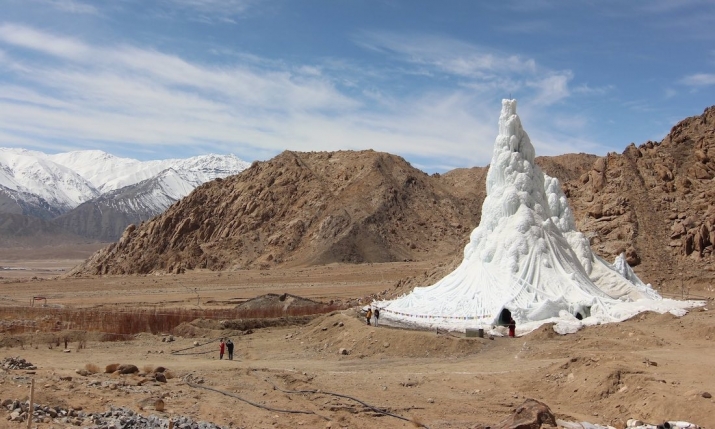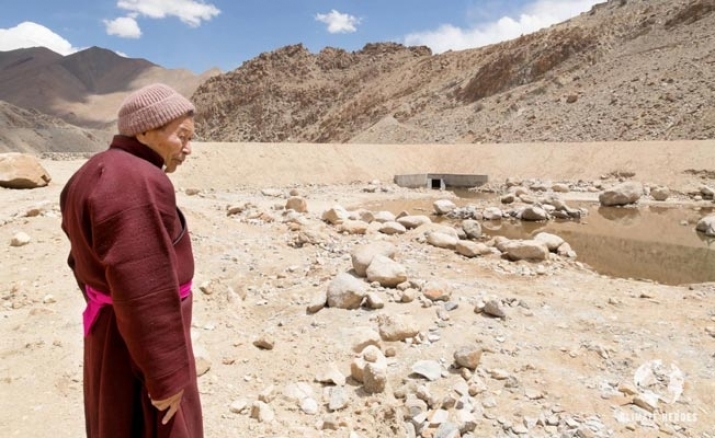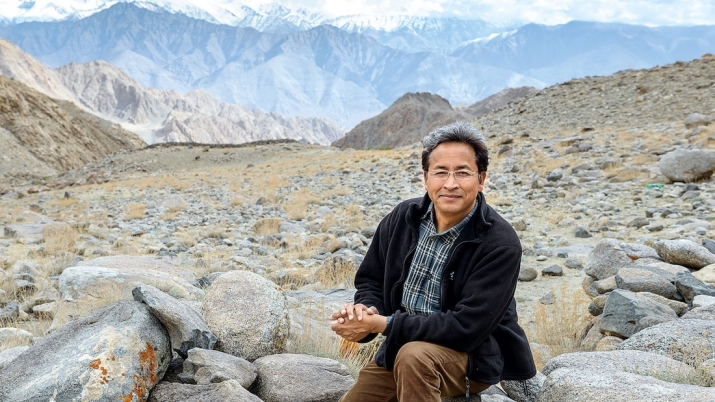NEWS
Ice Stupas Address Springtime Water Shortage in India’s Far North
 One of Sonam Wangchuk's ice stupas in Ladakh. Image courtesy of Sonam Wangchuk. From theguardian.com
One of Sonam Wangchuk's ice stupas in Ladakh. Image courtesy of Sonam Wangchuk. From theguardian.comFor many people living in Ladakh, in the northern Indian state of Jammu and Kashmir, the months April and May may not be very welcoming, bringing with them acute water shortages along with warmer weather. As the rivers and the streams in this Himalayan region run dry during this season, most of the people living here—where many villages are at elevations as high as 4,000 meters—are compelled to seek other means of obtaining water for their daily needs. This water crisis is mainly believed to be due to climate change.
In March 2010, The Hindu newspaper reported that since 1993 farmers in the region have noticed a dramatic decline in plant biodiversity, increasingly warmer temperatures, and shrinking natural waterways. However, civil engineers have come up with an innovative idea to address the water shortage in the form of artificial glaciers known as “ice stupas,” bringing hope to the more than 80 per cent of farmers in the region who depend on snow melt for irrigation.
Chewang Norphel, a 79-year-old civil engineer who has been dubbed “Ice Man,” said the ice stupa concept was initially difficult for local residents to understand. “. . . everybody tends to laugh at me and my purposes, and how I ventured to this project with my full speed and dedication. . . . Thank God, in the end it was a big success and people approved it.” When the artificial glaciers were formed at lower altitudes, the ice stupas have resulted in significant replenishment of groundwater, as well as supplying much-needed water for irrigation and domestic use. (Climate Heroes)
 Chewang Norphel by an almost dry stream in Ladakh. From climateheroes.org
Chewang Norphel by an almost dry stream in Ladakh. From climateheroes.orgAnother Ladakhi engineer, Sonam Wangchuk, also started building ice stupas to help local residents cope with the water crisis. In an interview with Earth Island Journal in which he admitted that he was inspired by Norphel, Wangchuk spoke about his ambitious plan to expand his focus beyond meeting agricultural needs. “Apart from [supplying] water to the farmers, in future ice stupas will host ice hotels inside them. These ice hotels will be a special experience for tourists and when they melt it will [provide] water for the farmers. A win-win situation.”
The 50-year-old related how the acute water shortage had seemed to be insurmountable problem for the region until he notice how chunks of ice in shaded areas remained long after the more exposed ice around them had melted. “I understood that it was not the warmth of the sun that was melting the ice on the ground. It was direct sunlight.” (The Guardian)
However, while Wangchuk, unlike Norphel, did not have to face people laughing at his ideas, he was confronted by a rather different conundrum when building ice stupas. “The ice needed to be shaded—but how? We couldn’t have it under a bridge, or use reflectors, which aren’t practical at scale. So we thought of this conical shape: making ice shade itself.” (The Guardian)
The conical shape, which maximizes the volume of ice that can be stored, minimizes the surface area exposed to direct sunlight, meaning the ice stupas are able to continue gradually melting into the spring, releasing up to 5,000 liters of water each day. The physical resemblance of these artificial glaciers to the traditional Buddhist stupas that dot the landscape of this Buddhist region mean the local populace have embraced the concept with enthusiasm. “Because it resembles something we have in our tradition, it is made more close to the population, to their hearts,” Wangchuk said. (The Guardian)
The basic principle behind the ice stupas is very simple, requiring only an upstream water source, water pipe to channel the water to the ice stupa, and extreme low temperatures of –30° to –50° Celsius, whichare quite common at night. The water is drawn through the pipe, which is mounted on a mobile tower. When the temperature drops, the water sprinkled from the tower freezes into the iconic conical shape.
Both engineers have won prestigious awards for their innovative projects. According to The Guardian, Chewang Norphel has created 11 reservoirs that have supplied water to some 10,000 people. In 2012, award-winning documentary filmmaker Aarti Shrivastava directed the short film White Knight, which documents Norphel’s life and achievements, and has been screened in India and internationally. Sonam Wangchuk, has received the prestigious Rolex Award for enterprise, which has provided much-needed funding to help him continue his work.
 Sonam Wangchuk on the desert hills of Ladakh. From gqIndia.com
Sonam Wangchuk on the desert hills of Ladakh. From gqIndia.comSee more
The ice stupas of Ladakh: solving water crisis in the high desert of Himalaya (The Guardian)
Articifial glaciers of Ladakh (The Ice Stupa Project)
‘Building Artificial Glaciers Is an Enterprise of the Future’ (Earth Island Journal)
Chewang Norphel, ice man’s dams in the Himalayas (Climate Heroes)
Ice towers in the desert (Rolex)
The glacier melt (The Hindu)














